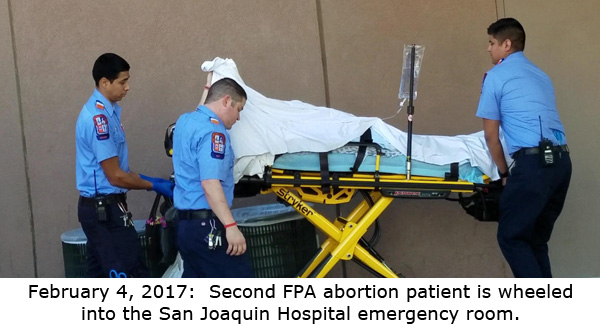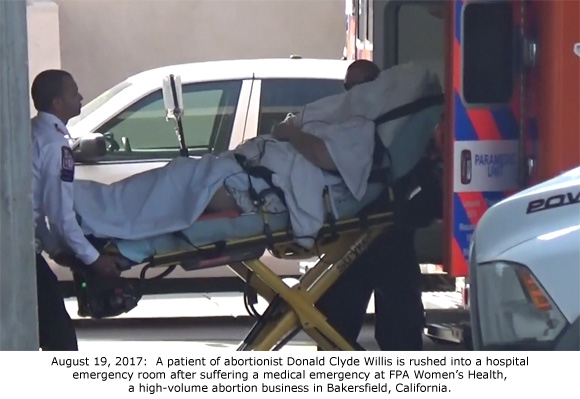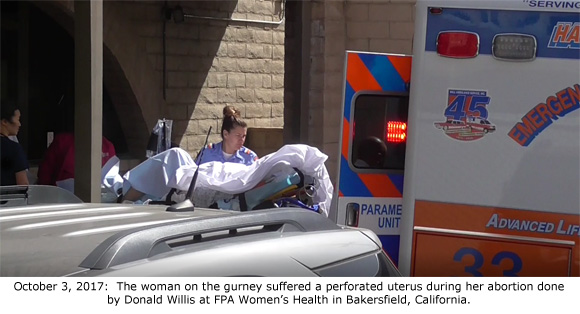
By Cheryl Sullenger
Bakersfield, CA – A dangerous California abortionist who was responsible for hospitalizing six women with life-threatening complications within a nine-month period of time in 2017, has entered an agreement to surrender his medical license, effective November 25, 2020.
Donald Clyde Willis was employed at the FPA Women’s Health abortion facility in Bakersfield, California, at the time of the abortion-related emergencies.
Operation Rescue filed a formal complaint with the California Medical Board (CMB) against Willis on October 3, 2017 — the same day that the sixth medical emergency took place. An Operation Rescue staff member was interviewed by a Medical Board investigator regarding the case, which led to a formal accusation against Willis related to three of the injured women.
Willis agreed to surrender his California medical license to avoid expensive disciplinary action.
“We are rejoicing today that this abortionist can no longer take the lives of innocent babies or inflict further harm on women,” said Operation Rescue President Troy Newman. “Protecting women and their babies from incompetent and dangerous abortionists is a big part of why we do this work. We are grateful for the California Medical Board’s action in this case.”
The CMB accusation, dated August 7, 2020, against Willis detailed multiple allegations of gross negligence, repeated negligent acts, and failure to maintain adequate and accurate medical records for his handling of the three women’s abortions.
Patient A

Patient A, 28, was 17 weeks 3 days pregnant when she reported to the FPA Women’s Health facility for the final day of a Dilation and Evacuation (D&E) dismemberment abortion on February 4, 2017.
After the abortion, her bleeding increased, so Willis returned her to the operating room where he conducted a second abortion to remove tissue left behind by the first attempt. Fearing he had perforated her uterus, Willis transferred Patient A by ambulance to the nearby Kern Medical Center, but emergency room staff found no evidence of a perforation.
However, Willis’ medical records were a disaster. He failed to document several aspects of Patient A’s abortion, including “what tissues were removed” during the abortion, leaving hospital physicians in the dark. His failure to provide accurate and complete medical records rose to the level of gross negligence according to the formal accusation.
Patient B

Patient B was 23-years old when Willis conducted a D&E dismemberment abortion on her baby at 14 weeks 2 days gestation on August 19, 2017. Willis tore her cervix during the abortion, resulting in significant blood loss.
Willis was unable to repair the tear and was unsure whether the baby’s head was inside her uterus or vagina at the time she was transported by ambulance to the Kern Medical Center, where she underwent emergency surgery where the remainder of her baby’s body was removed and her cervical tear repaired.
Once again, Willis was accused of committing gross negligence due to his shoddy record-keeping, which hindered hospital physicians.
Patient C

Of the three women mentioned in the allegation, Patient C suffered the worst. She was a 23-year old with a history of two prior cesarean section deliveries. She was 11 weeks 1 day pregnant at the time of her suction aspiration abortion on October 3, 2017.
Due to her unusual anatomy, Willis could not visualize the opening of the cervix, yet he blindly continued on with the abortion without the aid of ultrasonography. During the surgery, Willis was unable to remove any parts of the baby, but the mother lost 500 ml of blood, the equivalent of 17.6 fluid ounces.
When her vital signs became unstable, she was rushed to the hospital by ambulance where she was treated for hemorrhagic shock and severe internal injuries. Patient C received four units of blood and underwent emergency surgery, during which she suffered cardiac arrest. After being successfully resuscitated, she underwent a total abdominal hysterectomy with removal of a damaged ovary and Fallopian tube. She received an additional 10 units of blood and was hospitalized for five days.
Willis’ medical records, which should have documented his treatment of Patient C, were woefully incomplete. The Board determined that Willis did not account for potential risk factors when conducting her abortion and failed to reschedule her abortion for when he had ultrasound assistance available.
Mental health issues
Willis also suffered from mental health issues related to an attempted suicide after a divorce in 1993. Willis had gone to a park near his Oregon home and shot himself in the forehead with a revolver. He was found later still alive, and was transported to a hospital where he underwent surgery to remove bone fragments and part of his brain. He spent three months in a mental institution. Because Oregon placed several restrictions on his medical license after the suicide attempt, he later relocated to California where he could work without a restricted license – a decision that led to the serious abortion injuries for which he has now surrendered his license.
Need for disciplinary reforms
“While I am happy about the outcome, I’m disturbed that it took three long years to reach a conclusion in this case. Medical boards work very slowly and often allow incompetent physicians to continue practicing in cases that will likely result in license surrender or revocation. This creates a huge risk to the public,” said Newman. “Operation Rescue advocates for disciplinary reforms in every state that will speed the legal disciplinary process and add protections for the public when a physician demonstrates a significant threat to life and limb.”
______
Note: Photos provided by Tim and Terri Palmquist, without whose help this case would not have been possible.





